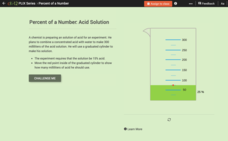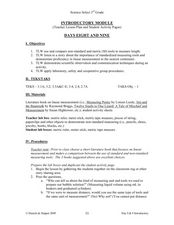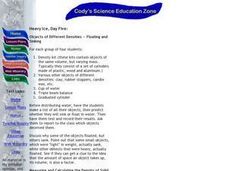Curated OER
Turn Up the Volume
Measuring volume can be a mystery for 5th graders, but this hands-on activity gives the gift of discovery. The volume of simple rectangular solids and irregular shapes are calculated through various methods including displacing liquid in...
Virginia Department of Education
Surface Area and Volume
Partners use materials to wrap three-dimensional objects to determine the formula for surface area. The groups use an orange to calculate the amount of peel it takes to completely cover the fruit. Using manipulatives, individuals then...
Curated OER
Down The Line
Learnersinvestigate three-dimensional shapes. In this geometry activity, pupils calculate the volume of cylinders using the given dimensions. They create a formula base don observation before using the real formula.
Curated OER
Mass, Volume, and Weight
Students explore mass, volume, and weight. In this science and measurement instructional activity, students compare volume, mass, and weight after listening to the teacher's description of each. Students explore different scales and...
Curated OER
Measuring Liquid Volume & Reading Thermometers
In this liquid volume worksheet, students first practice measuring liquid volume by determining what volume is indicated on each of the graduated cylinders in milliliters for the first nine problems. Then they determine the temperature...
CK-12 Foundation
Percent of a Number: Acid Solution
Mathematicians answer five questions about percents, ratios, and proportions with help from an interactive graduated cylinder. Question types include multiple-choice, fill-in-the-blank, and discussion.
02 x 02 Worksheets
Measuring Length
Your young forensic scientists add to and strengthen their measurement and conversion skills with these seven well-scaffold worksheets. Metric conversions, measuring length, area, and volume, reading thermometers, graduated cylinders,...
Curated OER
Volume of Irregular Objects
Fifth graders experiment using a Meniscus. In this volume lesson, 5th graders identify the volume of irregular objects using the process of water displacement. Students record data and draw conclusions.
Curated OER
Density
Students find the mass, volume, and density of various objects. In this density measurement instructional activity, students observe how same-sized objects can have different masses, then use water displacement to find the density of...
Curated OER
Significant Figures and Measurement
In this science worksheet, students draw several markings on a ruler or graduated cylinder or thermometer to get each of the correct measurements. Then they state what place the marking indicates and the number of significant figures in...
Curated OER
Mystery Liquids: Linear Function
High schoolers determine the linear equations of the density of water and oil by collecting data on the mass of various volumes of each liquid. They construct scatter plots from the data and use these to write the linear equations for...
Curated OER
The Handley Smokestack Problem
In this smokestack instructional activity, students determine the length of a stripe that winds around a cylinder shaped smokestack. This one page instructional activity contains one multi-step problem. The answer is provided at the...
Curated OER
Who Has the Biggest Mouth?
Students divide into groups of three or four, elect in their group who they think has the biggest mouth. This question will be followed by Mrs. Peters' joke about big mouths and frogs. Students then be asked how they could prove to the...
Curated OER
Estimating the Live Mass of Dinosaurs
Students calculate the volume of scale model dinosaurs using a water displacement method. They use formulas to calculate the live mass each of the species of dinosaur. Then they complete and discuss a series of questions.
Mr. Hill's Science Website
Density Workbook
It's all about density! Here's a dense workbook for young scientists; they solve (and show work for) 29 density word problems, including a problem where they solve for the density of Godzilla. They complete labs analyzing metal cubes,...
Pennsylvania Department of Education
Determine Volume of Solids Using Water Displacement
Students explore math functions by completing math equation worksheets. In this inequality lesson, students define a list of math terms and discuss the difference between an equation and inequality. Students utilize a real life situation...
Curated OER
Everybody Needs a Rock
Here is a lesson that rocks! Young scientists choose a rock and list words that describe it. They estimate the mass of their rocks and rank them within a group. They measure their rocks for volume and write a story that somehow includes...
Curated OER
Causal Patterns in Density Phenomena
Students investigate the relationship between volume and mass in different liquids such as vegetable oil, rubbing alcohol and water. They measure the mass of several different volumes of each liquid and then graph the results as well as...
Curated OER
Everybody Needs a Rock
Students describe and classify rocks that they have chosen. They estimate and find the mass of their rocks.
Curated OER
Measure Twice
Students measure a variety of objects using the appropriate measuring tool. In this measurement lesson, students explain the importance of accuracy and precision in collecting data. They discuss the difference between the two.
Curated OER
Introductory Module
Third graders examine the non-standard method of measurement and compare it to the metric system of measurement. In this introductory module lesson, 3rd graders discover the scientific observation. Students also develop communication...
Curated OER
Discovering Density
Students explore the physical properties of density. In this hands-on lesson, students calculate density and distinguish between intensive and extensive properties.
Curated OER
Heavy Ice: Day Five
Students explore physics by conducting a class experiment. In this density lesson plan, students examine a list of items and discuss whether they will sink or float and then determine their density. Students examine the objects over five...
Curated OER
Using Concept Maps to Design 3D Spheres
Students create three dimensional shapes using concept maps. For this geometry lesson, students investigate the impact of mental schemas on humans. They collect data on this topic and plot their data on a coordinate plane.

























